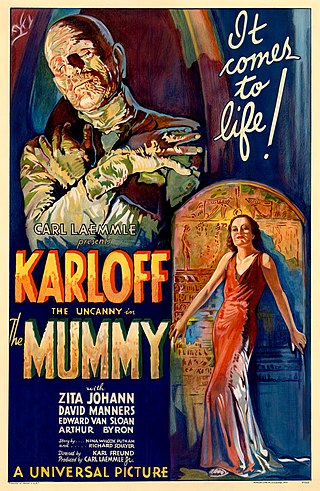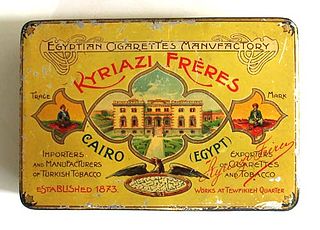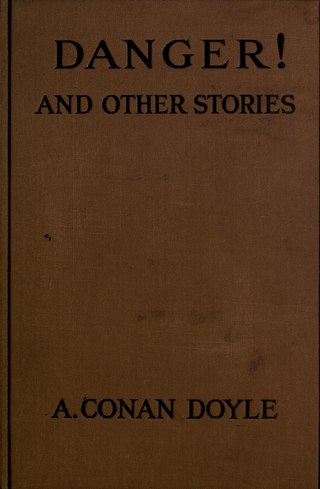
Gothic fiction, sometimes called Gothic horror, is a loose literary aesthetic of fear and haunting. The name refers to Gothic architecture of the European Middle Ages, which was characteristic of the settings of early Gothic novels.

Horror is a genre of fiction that is intended to disturb, frighten or scare. Horror is often divided into the sub-genres of psychological horror and supernatural horror, which are in the realm of speculative fiction. Literary historian J. A. Cuddon, in 1984, defined the horror story as "a piece of fiction in prose of variable length... which shocks, or even frightens the reader, or perhaps induces a feeling of repulsion or loathing". Horror intends to create an eerie and frightening atmosphere for the reader. Often the central menace of a work of horror fiction can be interpreted as a metaphor for larger fears of a society.

Arthur Machen was the pen-name of Arthur Llewellyn Jones, a Welsh author and mystic of the 1890s and early 20th century. He is best known for his influential supernatural, fantasy, and horror fiction. His novella The Great God Pan has garnered a reputation as a classic of horror, with Stephen King describing it as "Maybe the best [horror story] in the English language." He is also well known for "The Bowmen", a short story that was widely read as fact, creating the legend of the Angels of Mons.

George Edward Stanhope Molyneux Herbert, 5th Earl of Carnarvon,, styled Lord Porchester until 1890, was an English peer and aristocrat best known as the financial backer of the search for and excavation of Tutankhamun's tomb in the Valley of the Kings.

The Mummy is a 1932 American pre-Code supernatural horror film directed by Karl Freund. The screenplay by John L. Balderston was adapted from a treatment written by Nina Wilcox Putnam and Richard Schayer. Released by Universal Studios as a part of the Universal Classic Monsters franchise, the film stars Boris Karloff, Zita Johann, David Manners, Edward Van Sloan and Arthur Byron.

Tales from the Darkside: The Movie is a 1990 American comedy horror anthology film directed by John Harrison, serving as a spin-off of the anthology television series Tales from the Darkside. The film depicts the frame story of a kidnapped paperboy who tells three stories of horror to the suburban witch who is preparing to eat him.

The Jewel of Seven Stars is a horror novel by Irish writer Bram Stoker, first published by Heinemann in 1903. The story is a first-person narrative of a young man pulled into an archaeologist's plot to revive Queen Tera, an ancient Egyptian mummy. It explores common fin de siècle themes such as imperialism, the rise of the New Woman and feminism, and societal progress.

The Mummy, or Ramses the Damned is a 1989 horror novel by American writer Anne Rice. Taking place during the early twentieth century, it follows the collision between a British archeologist's family and a resurrected mummy. The novel ends with the statement, "The Adventures of Ramses the Damned Shall Continue", and twenty-eight years later, Rice fulfilled this promise with Ramses the Damned: The Passion of Cleopatra, written in collaboration with her son, novelist Christopher Rice. A third jointly-authored novel in this series, Ramses the Damned: The Reign of Osiris, was released on February 1, 2022, two months after Anne Rice's death.
Everett Franklin Bleiler was an American editor, bibliographer, and scholar of science fiction, detective fiction, and fantasy literature. In the late 1940s and early 1950s, he co-edited the first "year's best" series of science fiction anthologies, and his Checklist of Fantastic Literature has been called "the foundation of modern SF bibliography". Among his other scholarly works are two Hugo Award–nominated volumes concerning early science fiction—Science-Fiction: The Early Years and Science-Fiction: The Gernsback Years—and the massive Guide to Supernatural Fiction.

Sir Arthur Ignatius Conan Doyle was a British writer and physician. He created the character Sherlock Holmes in 1887 for A Study in Scarlet, the first of four novels and fifty-six short stories about Holmes and Dr. Watson. The Sherlock Holmes stories are milestones in the field of crime fiction.

The curse of the pharaohs or the mummy's curse is a curse alleged to be cast upon anyone who disturbs the mummy of an ancient Egyptian, especially a pharaoh. This curse, which does not differentiate between thieves and archaeologists, is claimed to cause bad luck, illness, or death. Since the mid-20th century, many authors and documentaries have argued that the curse is 'real' in the sense of having scientifically explicable causes such as bacteria, fungi or radiation. However, the modern origins of Egyptian mummy curse tales, their development primarily in European cultures, the shift from magic to science to explain curses, and their changing uses—from condemning disturbance of the dead to entertaining horror film audiences—suggest that Egyptian curses are primarily a cultural, not scientific, phenomenon.

"Some Words with a Mummy" is a satirical short story by American writer Edgar Allan Poe. It was first published in The American Review: A Whig Journal of Politics, Literature, Art and Science in April 1845. It is an important early portrayal of a revived Egyptian mummy.

The Egyptian cigarette industry, during the period between the 1880s and the end of the First World War, was a major export industry that influenced global fashion. It was notable as a rare example of the global periphery setting trends in the global center in a period when the predominant direction of cultural influence was the reverse, and also as one of the earliest producers of globally traded manufactured finished goods outside the West.

Danger! And Other Stories is a collection of short stories by Sir Arthur Conan Doyle published in 1918.

The Narrative of John Smith (2011) is a novel written in 1883 by Arthur Conan Doyle, published posthumously by The British Library. In a work of narrative fiction, Doyle writes from the perspective of a middle-aged bachelor named John Smith recovering from rheumatic gout. Unlike his later work in detective fiction, fantasy, and science fiction, this novel unfolds through a series of tangential, essay-like thoughts stemming from observations on everyday life. The subjects are of a “personal-social-political complexion”.
Roger Luckhurst is a British writer and academic and since 2020 the Geoffrey Tillotson Chair of Nineteenth Century Studies at Birkbeck College. He was appointed professor in modern and contemporary literature in the Department of English, Theatre, and Creative Writing at Birkbeck, University of London in 2008 and was distinguished visiting professor at Columbia University in 2016. He works on Victorian literature, contemporary literature, Gothic and weird fiction, trauma studies, and speculative/science fiction. Luckhurst is notable for his introductions and editorships to the Oxford World's Classics series volumes -- Late Victorian Gothic Tales,Dracula, Strange Case of Dr Jekyll and Mr Hyde, The Portrait of a Lady, H.P. Lovecraft's Classic Horror Tales, King Solomon’s Mines, and The Time Machine -- and for his books on J. G. Ballard (1997), The Invention of Telepathy (2002), Science Fiction (2005) The Trauma Question (2008), The Mummy’s Curse: The True Story of a Dark Fantasy, and Zombies: A Cultural History. He has also written two books for the British Film Institute classic film series on The Shining and Alien.

Mummies are commonly featured in horror genres as undead creatures wrapped in bandages. Similar undead include skeletons and zombies.
Henrietta Dorothy Everett who wrote under the pen name Theo Douglas was a British novelist who was popular during her lifetime but who is now largely forgotten. Her identity was revealed in 1910 but little is known of her life.

The tomb of Tutankhamun was discovered in the Valley of the Kings in 1922 by excavators led by the Egyptologist Howard Carter, more than 3,300 years after Tutankhamun's death and burial. Whereas the tombs of most pharaohs were plundered by graverobbers in ancient times, Tutankhamun's tomb was hidden by debris for most of its existence and therefore not extensively robbed. It thus became the first known largely intact royal burial from ancient Egypt.
Lot No. 249 is a supernatural television drama produced by the BBC based on the story "Lot No. 249" by British writer Arthur Conan Doyle, first published in Harper's Magazine in 1892. Adapted and directed by Mark Gatiss, it stars Kit Harington and Freddie Fox and was first broadcast on 24 December 2023 on BBC Two as part of the long-running A Ghost Story for Christmas series.



















